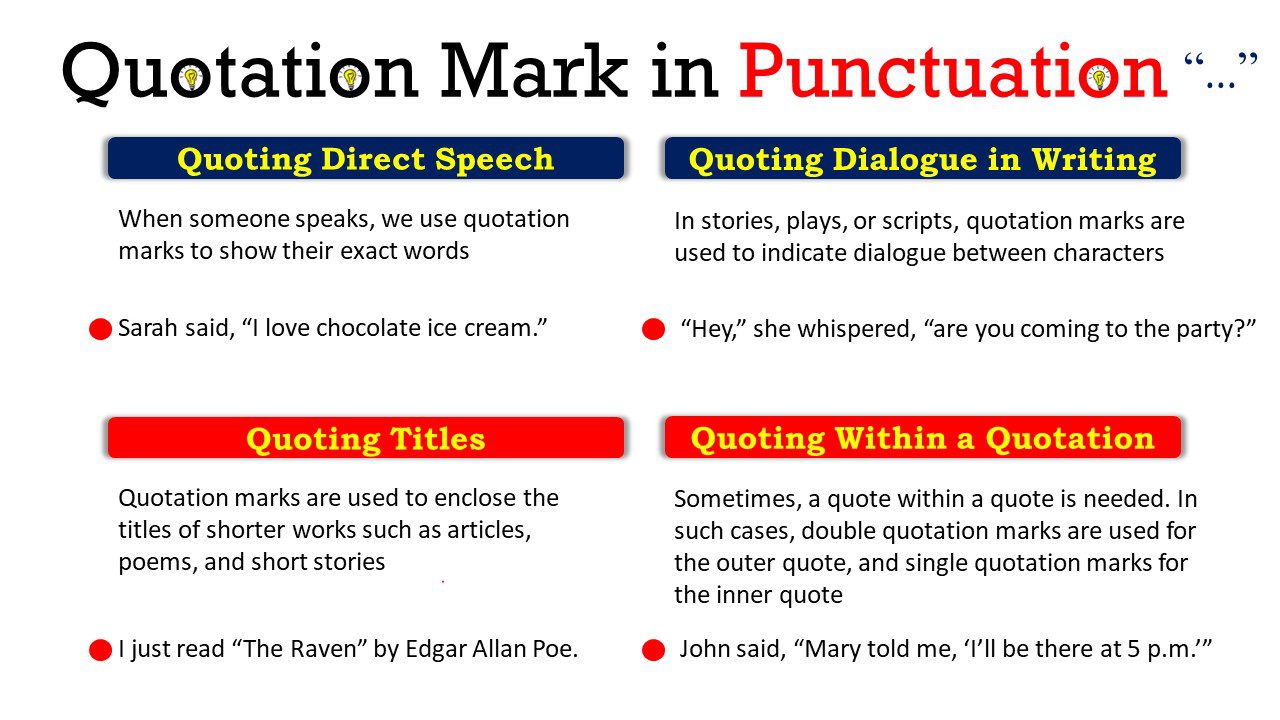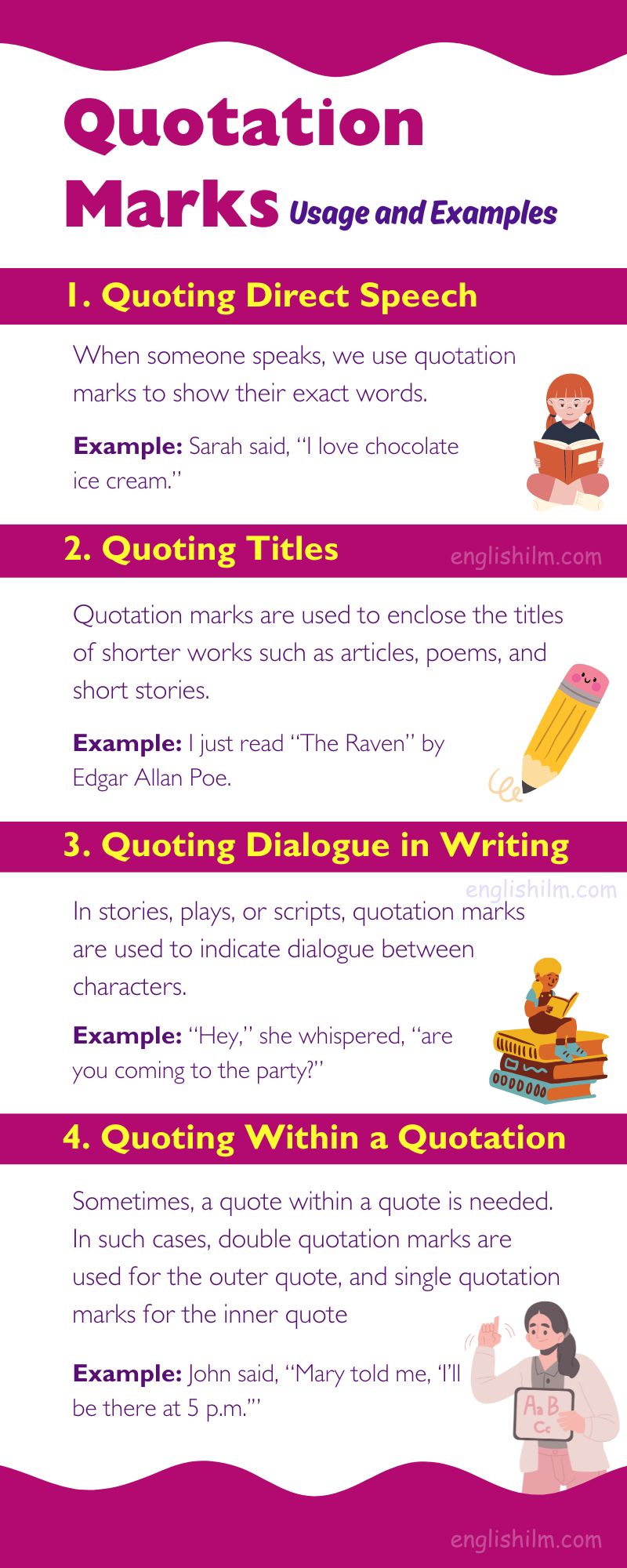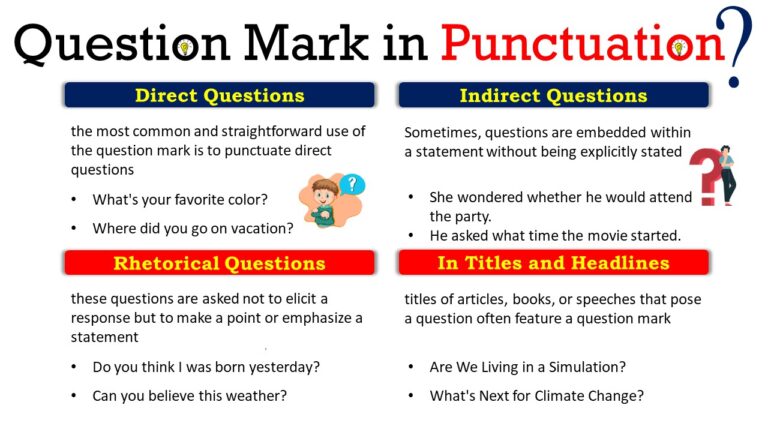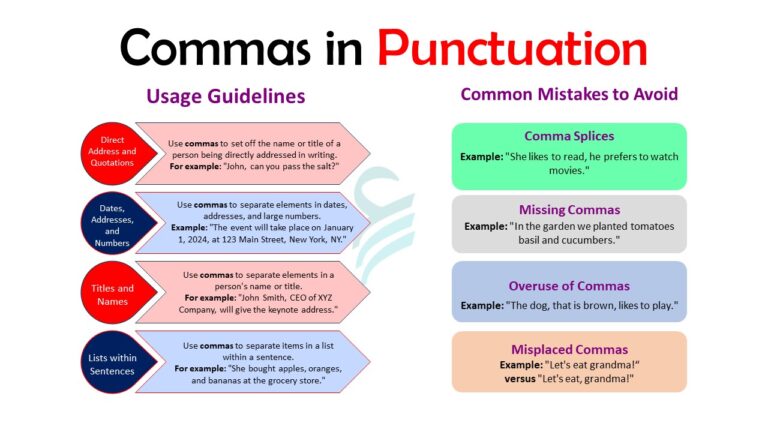In this blog post, you will learn about the quotation mark, a key part of punctuation in English. We will explore its main uses and rules to help you understand how to use quotation marks correctly in writing. By studying the full lesson, you’ll be able to improve your grammar skills and apply these rules effectively.
What are Quotation Marks?
Quotation marks are those curly little symbols we use in writing to indicate spoken or quoted language.
They come in pairs: an opening quotation mark (“) and a closing quotation mark (”). Together, they create a boundary that encloses the quoted text. Here are some examples that are going to help you understand quotation marks:
- “The cat ‘meowed’ loudly outside my window.”
- She said, “I’ll be there at 3 o’clock sharp.”
- He wrote a note that read, “Don’t forget to buy milk!”
- “What do you mean by ‘impossible’?” she asked incredulously.
- The sign said, “Closed for maintenance.”
Types of Quotation Mark
Quotation marks, also known as inverted commas, come in several forms that vary based on language and typographic conventions. Here are some common types:
- Straight Quotation Marks
- Curly Quotation Marks
- Guillemets
- German Quotation Marks
- Single Quotation Marks
- Half-Quotation Marks
- Neutral Quotation Marks
1. Straight Quotation Marks ✔
These are simple vertical marks ("for double quotes,' for single quotes) and are commonly used in English-language texts.
For example:
- John said, “I’ll meet you at the cafe at 5 o’clock.”
- She whispered, ‘Please be quiet.’
2. Curly Quotation Marks ✔
Also known as smart quotes or typographer’s quotes, these are curved marks (“ ” for double quotes, ‘ ’ for single quotes). They are considered more visually appealing and are often used in professional typesetting.
For example:
- The professor emphasized, “It’s crucial to cite your sources accurately.”
- In her essay, she wrote, ‘The author argues that language shapes our perception of reality.’
3. Guillemets ✔
These are angle quotation marks (« » or ‹ ›) commonly used in languages such as French, Russian, and Spanish, among others. They indicate speech or a quotation in many languages outside the English-speaking world.
For example:
- Pierre declared, «Je suis très content de te voir» (I am very happy to see you).
- El libro comienza con el proverbio «La verdad os hará libres» (The book begins with the proverb “The truth will set you free”).
4. German Quotation Marks ✔
In German typography, quotation marks are often set as double angular marks („ “ or » «) and are used in a manner similar to English quotes.
For example:
- “Das ist ein schöner Tag”, sagte Anna ( “This is a beautiful day,” said Anna).
- „Ich liebe dich“, flüsterte er ( “I love you,” he whispered).
5. Single Quotation Marks ✔
While English typically uses double quotation marks for direct speech or quotations, single quotation marks (‘ ‘) are often used to denote nested quotes or quotations within quotations.
For example:
- He replied, “She told me, ‘I’ll be there in a minute.'”
- The teacher asked, “Who said, ‘The pen is mightier than the sword’?”
6. Half-Quotation Marks ✔
These are used in some languages to indicate a partial quote or to highlight a specific word. For instance, the single closing angle quote (›) is used in Greek to mark an emphasized word within a quotation.
For example:
- The advertisement read: “The ‘best’ pizza in town!”
- He stressed the importance of ‘patience’ in learning a new language.
7. Neutral Quotation Marks ✔
Some languages, such as Icelandic, use neutral quotation marks („ “) which are similar to English curly quotes but with a different orientation. For example:
- Sie sagte: „Ich bin bereit“ (She said, “I am ready”).
- “Þetta er góður dagur,” sagði hann ( “This is a good day,” he said).
Uses of Quotation Marks
1. Quoting Direct Speech
When someone speaks, we use quotation marks to show their exact words.
For example:
- Sarah said, “I love chocolate ice cream.”
2. Quoting Titles
Quotation marks are used to enclose the titles of shorter works such as articles, poems, and short stories.
For example:
- I just read “The Raven” by Edgar Allan Poe.
3. Quoting Dialogue in Writing
In stories, plays, or scripts, quotation marks are used to indicate dialogue between characters.
For example:
- “Hey,” she whispered, “are you coming to the party?”
4. Quoting Within a Quotation
Sometimes, a quote within a quote is needed. In such cases, double quotation marks are used for the outer quote, and single quotation marks for the inner quote.
For example:
- John said, “Mary told me, ‘I’ll be there at 5 p.m.’”
5. Quoting Slang or Unusual Words
When using slang terms or words in a non-standard way, quotation marks can signal to the reader that the word is being used in a specific context.
For example:
- He called it a “jam-packed” concert.
Rules for Using Quotation Marks
1. Always Use in Pairs
Quotation marks should always be used in pairs—an opening mark at the beginning of the quoted text and a closing mark at the end.
2. Punctuation Placement
In American English, commas and periods typically go inside the closing quotation mark. Question marks and exclamation points go inside the quotation mark if they are part of the quoted material, but outside if they are not.
For example:
- She asked, “Where are you going?” Did she say, “I love pizza”?
3. Separate Paragraphs
Each time a new speaker begins talking in dialogue, a new paragraph should start, even if it means using opening quotation marks at the start of each paragraph of the same dialogue.
4. Use the Emphasis Sparingly
While quotation marks can be used for emphasis, it’s best to use them sparingly to avoid confusion or diluting their impact.
5. Be Consistent
Stick to one style guide when using quotation marks to maintain consistency throughout your writing. Whether you prefer American or British conventions, choose one and stick with it.
Examples of Quotation Marks in Action
- Direct Speech: She exclaimed, “I can’t believe it’s already Friday!”
- Quoting Titles: I recently watched “The Shawshank Redemption” for the first time.
- Quoting Dialogue: “Do you want to grab dinner later?” asked Tom. “Sure,” replied Emily, “what time?”
- Quoting Within a Quotation: Mary said, “Josh told me, ‘I’ll be there in five minutes.’”
- Quoting Slang: The term “hangry” refers to being irritable due to hunger.
Common Errors with Usage of Quotation Marks
1. Incorrect: “I’m not sure if I can make it to the party tomorrow. There is so much work to do”, said Tom. ❌
Correct: “I’m not sure if I can make it to the party tomorrow. There is so much work to do,” said Tom. ✔
- Explanation: The comma should be placed inside the closing quotation mark as the dialogue continues after the speaker’s attribution.
2. Incorrect: She said, “The book is on the table”. ❌
Correct: She said, “The book is on the table.” ✔
- Explanation: A period should be inside the closing quotation mark to correctly end the sentence.
3. Incorrect: “I love pizza”, “burgers”, and “sushi”. ❌
Correct: “I love pizza,” “burgers,” and “sushi.” ✔
- Explanation: Each quoted item should be separated by commas and enclosed within individual sets of quotation marks.
4. Incorrect: John whispered, “Don’t tell anyone about this”. ❌
Correct: John whispered, “Don’t tell anyone about this.” ✔
- Explanation: The period should be inside the closing quotation mark to properly end the sentence.
5. Incorrect: “The movie was ‘amazing’,” she said. ❌
Correct: “The movie was ‘amazing’,” she said. ✔
- Explanation: Single quotation marks within double quotation marks are used to quote something within a quote, and they should be placed correctly within the sentence.
Question Mark vs. Quotation Mark
| Feature | Question Mark (?) | Quotation Mark (“) |
| Appearance | Curved line with a dot beneath it (?) | Vertical line placed above the baseline (“) |
| Function | Punctuation used to denote a question or inquiry | Punctuation used to indicate the start and end of a quotation or to highlight a specific word or phrase |
| Usage | Used at the end of direct questions in writing and informal speech | Used to enclose direct speech or dialogue in writing |
| Examples | “How are you?” | She said, “I’ll be there soon.” |
| Origin | Derived from Latin “quaestiō” meaning “question” | Derived from Latin “quot“ meaning “how many” |
Read more about: Question Mark in English
Quotation Marks in Punctuation Charts
Read More











